Risk Management Assessment
VerifiedAdded on 2023/04/22
|13
|3231
|397
AI Summary
This assessment covers the principles and guidelines of risk management. It includes tasks such as identifying risks, developing action plans, and monitoring and reviewing actions.
Contribute Materials
Your contribution can guide someone’s learning journey. Share your
documents today.
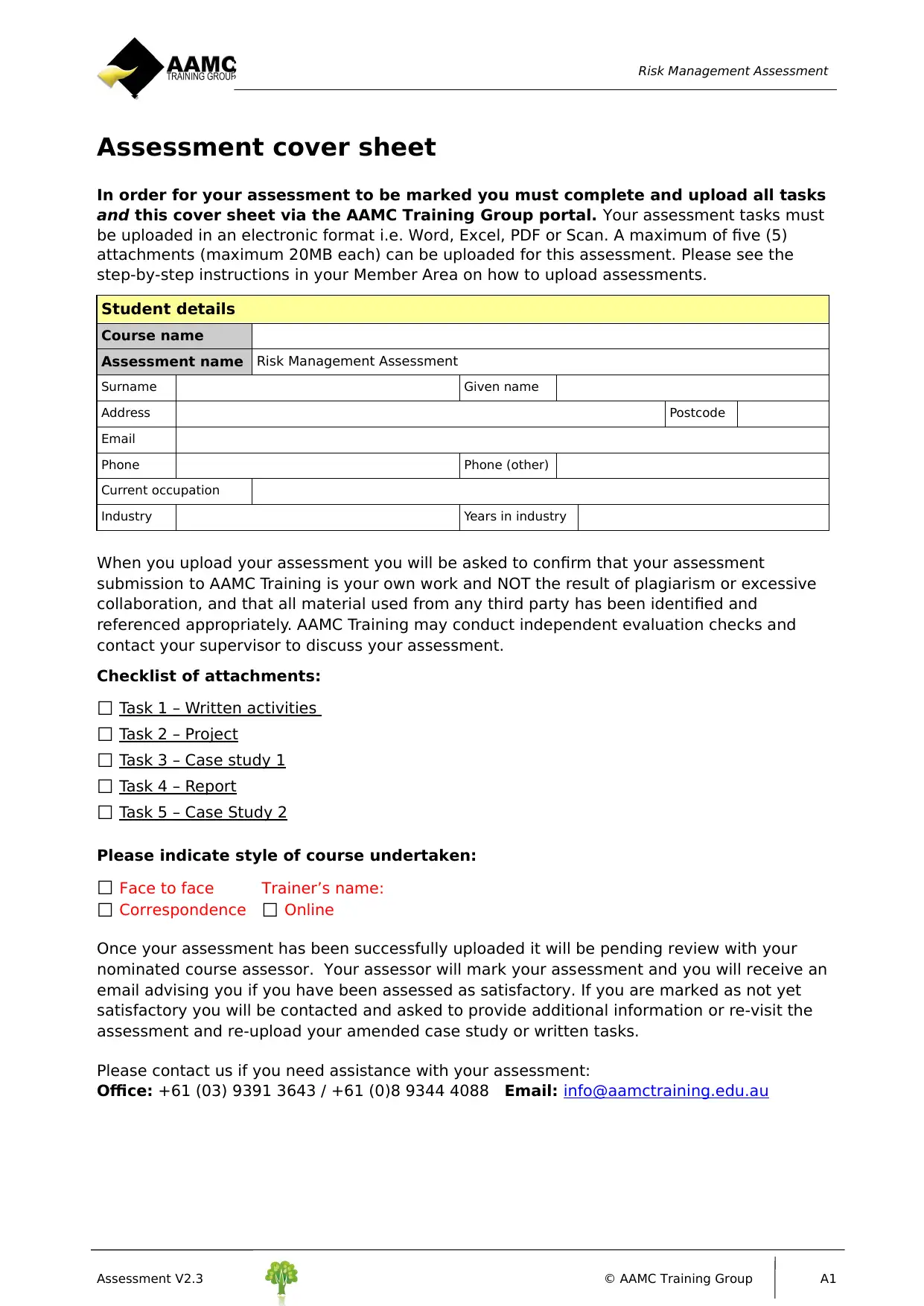
Risk Management Assessment
Assessment cover sheet
In order for your assessment to be marked you must complete and upload all tasks
and this cover sheet via the AAMC Training Group portal. Your assessment tasks must
be uploaded in an electronic format i.e. Word, Excel, PDF or Scan. A maximum of five (5)
attachments (maximum 20MB each) can be uploaded for this assessment. Please see the
step-by-step instructions in your Member Area on how to upload assessments.
Student details
Course name
Assessment name Risk Management Assessment
Surname Given name
Address Postcode
Email
Phone Phone (other)
Current occupation
Industry Years in industry
When you upload your assessment you will be asked to confirm that your assessment
submission to AAMC Training is your own work and NOT the result of plagiarism or excessive
collaboration, and that all material used from any third party has been identified and
referenced appropriately. AAMC Training may conduct independent evaluation checks and
contact your supervisor to discuss your assessment.
Checklist of attachments:
☐ Task 1 – Written activities
☐ Task 2 – Project
☐ Task 3 – Case study 1
☐ Task 4 – Report
☐ Task 5 – Case Study 2
Please indicate style of course undertaken:
☐ Face to face Trainer’s name:
☐ Correspondence ☐ Online
Once your assessment has been successfully uploaded it will be pending review with your
nominated course assessor. Your assessor will mark your assessment and you will receive an
email advising you if you have been assessed as satisfactory. If you are marked as not yet
satisfactory you will be contacted and asked to provide additional information or re-visit the
assessment and re-upload your amended case study or written tasks.
Please contact us if you need assistance with your assessment:
Office: +61 (03) 9391 3643 / +61 (0)8 9344 4088 Email: info@aamctraining.edu.au
Assessment V2.3 © AAMC Training Group A1
Assessment cover sheet
In order for your assessment to be marked you must complete and upload all tasks
and this cover sheet via the AAMC Training Group portal. Your assessment tasks must
be uploaded in an electronic format i.e. Word, Excel, PDF or Scan. A maximum of five (5)
attachments (maximum 20MB each) can be uploaded for this assessment. Please see the
step-by-step instructions in your Member Area on how to upload assessments.
Student details
Course name
Assessment name Risk Management Assessment
Surname Given name
Address Postcode
Phone Phone (other)
Current occupation
Industry Years in industry
When you upload your assessment you will be asked to confirm that your assessment
submission to AAMC Training is your own work and NOT the result of plagiarism or excessive
collaboration, and that all material used from any third party has been identified and
referenced appropriately. AAMC Training may conduct independent evaluation checks and
contact your supervisor to discuss your assessment.
Checklist of attachments:
☐ Task 1 – Written activities
☐ Task 2 – Project
☐ Task 3 – Case study 1
☐ Task 4 – Report
☐ Task 5 – Case Study 2
Please indicate style of course undertaken:
☐ Face to face Trainer’s name:
☐ Correspondence ☐ Online
Once your assessment has been successfully uploaded it will be pending review with your
nominated course assessor. Your assessor will mark your assessment and you will receive an
email advising you if you have been assessed as satisfactory. If you are marked as not yet
satisfactory you will be contacted and asked to provide additional information or re-visit the
assessment and re-upload your amended case study or written tasks.
Please contact us if you need assistance with your assessment:
Office: +61 (03) 9391 3643 / +61 (0)8 9344 4088 Email: info@aamctraining.edu.au
Assessment V2.3 © AAMC Training Group A1
Secure Best Marks with AI Grader
Need help grading? Try our AI Grader for instant feedback on your assignments.
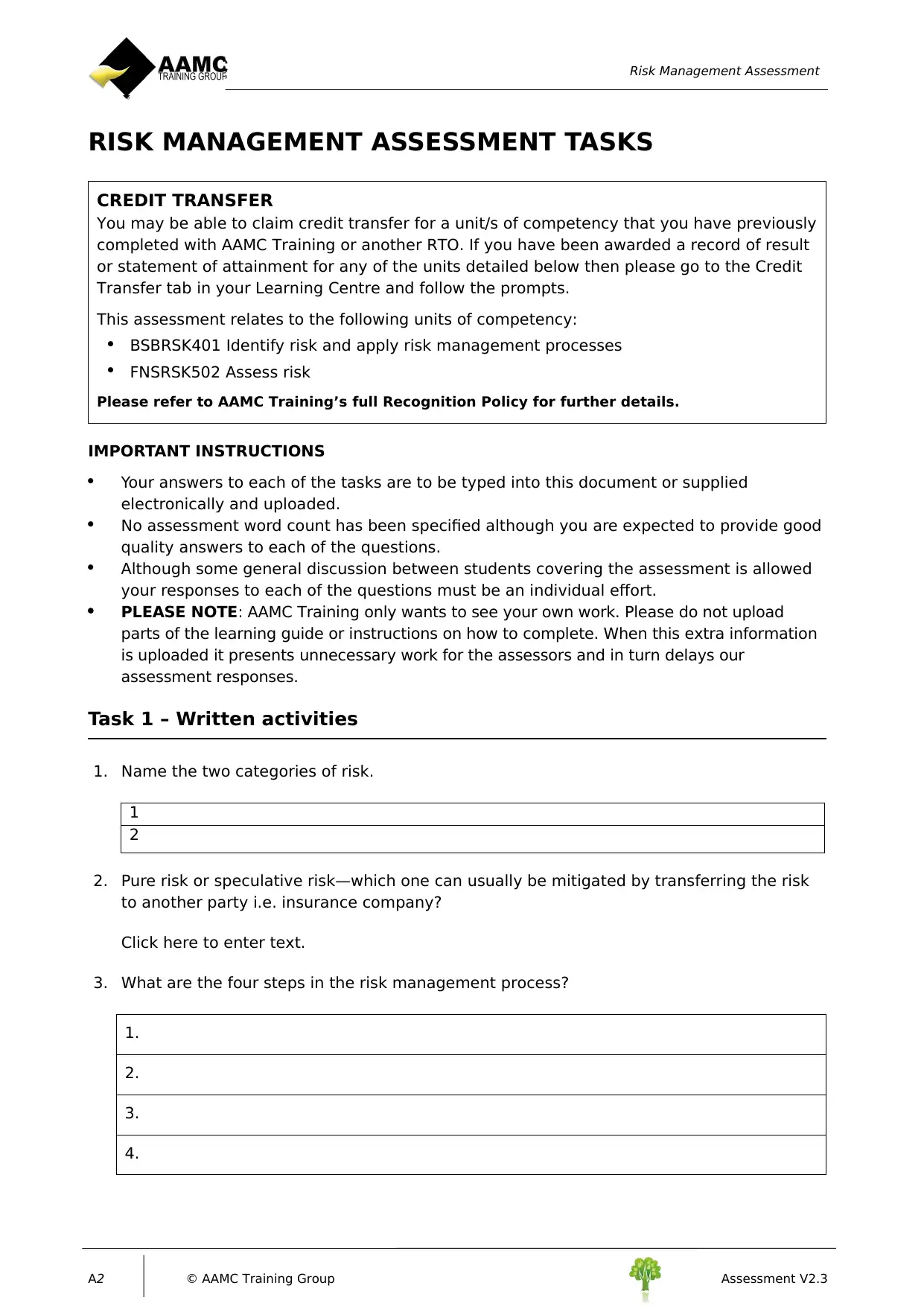
Risk Management Assessment
RISK MANAGEMENT ASSESSMENT TASKS
CREDIT TRANSFER
You may be able to claim credit transfer for a unit/s of competency that you have previously
completed with AAMC Training or another RTO. If you have been awarded a record of result
or statement of attainment for any of the units detailed below then please go to the Credit
Transfer tab in your Learning Centre and follow the prompts.
This assessment relates to the following units of competency:
BSBRSK401 Identify risk and apply risk management processes
FNSRSK502 Assess risk
Please refer to AAMC Training’s full Recognition Policy for further details.
IMPORTANT INSTRUCTIONS
Your answers to each of the tasks are to be typed into this document or supplied
electronically and uploaded.
No assessment word count has been specified although you are expected to provide good
quality answers to each of the questions.
Although some general discussion between students covering the assessment is allowed
your responses to each of the questions must be an individual effort.
PLEASE NOTE: AAMC Training only wants to see your own work. Please do not upload
parts of the learning guide or instructions on how to complete. When this extra information
is uploaded it presents unnecessary work for the assessors and in turn delays our
assessment responses.
Task 1 – Written activities
1. Name the two categories of risk.
1
2
2. Pure risk or speculative risk—which one can usually be mitigated by transferring the risk
to another party i.e. insurance company?
Click here to enter text.
3. What are the four steps in the risk management process?
1.
2.
3.
4.
A2 © AAMC Training Group Assessment V2.3
RISK MANAGEMENT ASSESSMENT TASKS
CREDIT TRANSFER
You may be able to claim credit transfer for a unit/s of competency that you have previously
completed with AAMC Training or another RTO. If you have been awarded a record of result
or statement of attainment for any of the units detailed below then please go to the Credit
Transfer tab in your Learning Centre and follow the prompts.
This assessment relates to the following units of competency:
BSBRSK401 Identify risk and apply risk management processes
FNSRSK502 Assess risk
Please refer to AAMC Training’s full Recognition Policy for further details.
IMPORTANT INSTRUCTIONS
Your answers to each of the tasks are to be typed into this document or supplied
electronically and uploaded.
No assessment word count has been specified although you are expected to provide good
quality answers to each of the questions.
Although some general discussion between students covering the assessment is allowed
your responses to each of the questions must be an individual effort.
PLEASE NOTE: AAMC Training only wants to see your own work. Please do not upload
parts of the learning guide or instructions on how to complete. When this extra information
is uploaded it presents unnecessary work for the assessors and in turn delays our
assessment responses.
Task 1 – Written activities
1. Name the two categories of risk.
1
2
2. Pure risk or speculative risk—which one can usually be mitigated by transferring the risk
to another party i.e. insurance company?
Click here to enter text.
3. What are the four steps in the risk management process?
1.
2.
3.
4.
A2 © AAMC Training Group Assessment V2.3
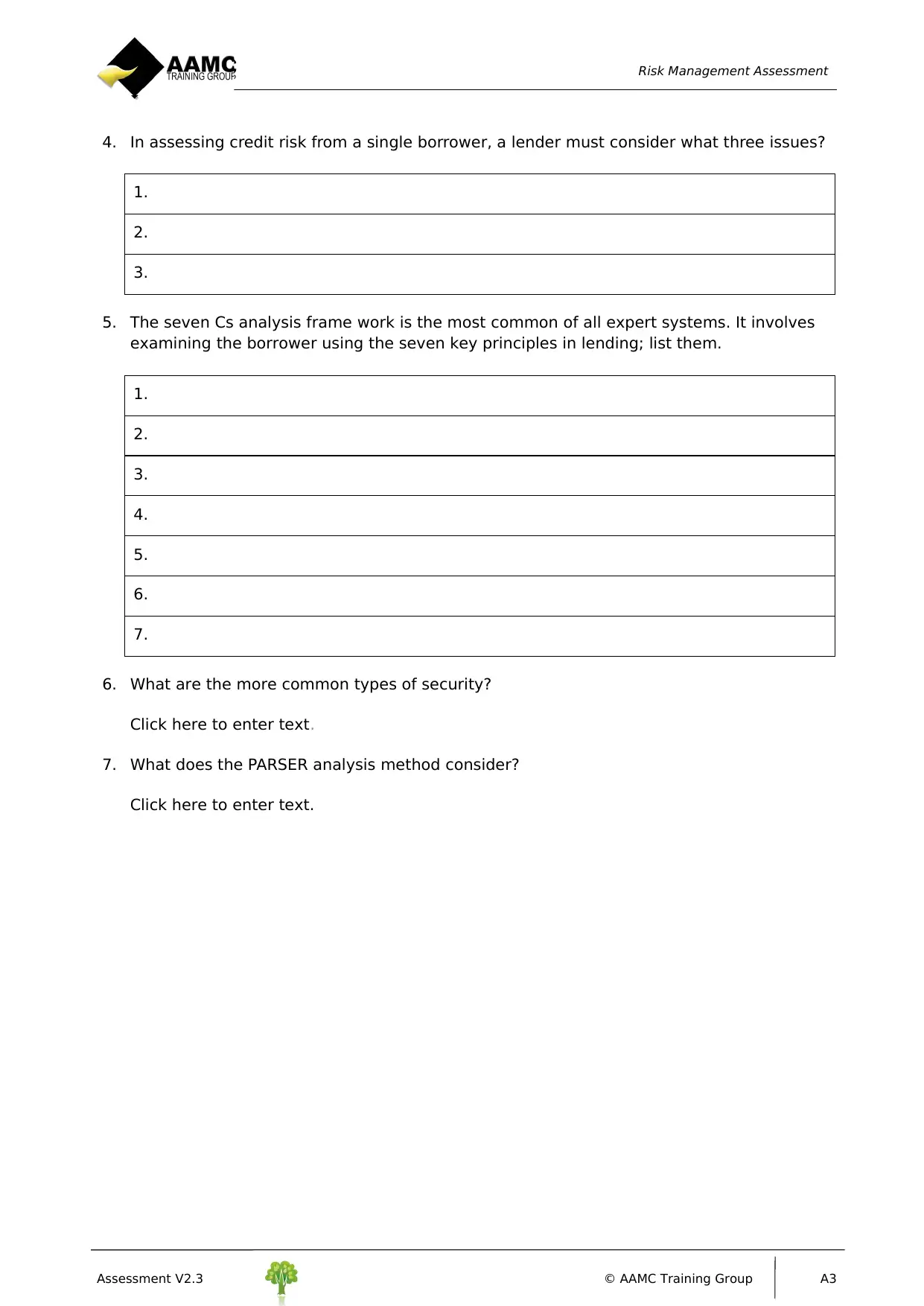
Risk Management Assessment
4. In assessing credit risk from a single borrower, a lender must consider what three issues?
1.
2.
3.
5. The seven Cs analysis frame work is the most common of all expert systems. It involves
examining the borrower using the seven key principles in lending; list them.
1.
2.
3.
4.
5.
6.
7.
6. What are the more common types of security?
Click here to enter text.
7. What does the PARSER analysis method consider?
Click here to enter text.
Assessment V2.3 © AAMC Training Group A3
4. In assessing credit risk from a single borrower, a lender must consider what three issues?
1.
2.
3.
5. The seven Cs analysis frame work is the most common of all expert systems. It involves
examining the borrower using the seven key principles in lending; list them.
1.
2.
3.
4.
5.
6.
7.
6. What are the more common types of security?
Click here to enter text.
7. What does the PARSER analysis method consider?
Click here to enter text.
Assessment V2.3 © AAMC Training Group A3
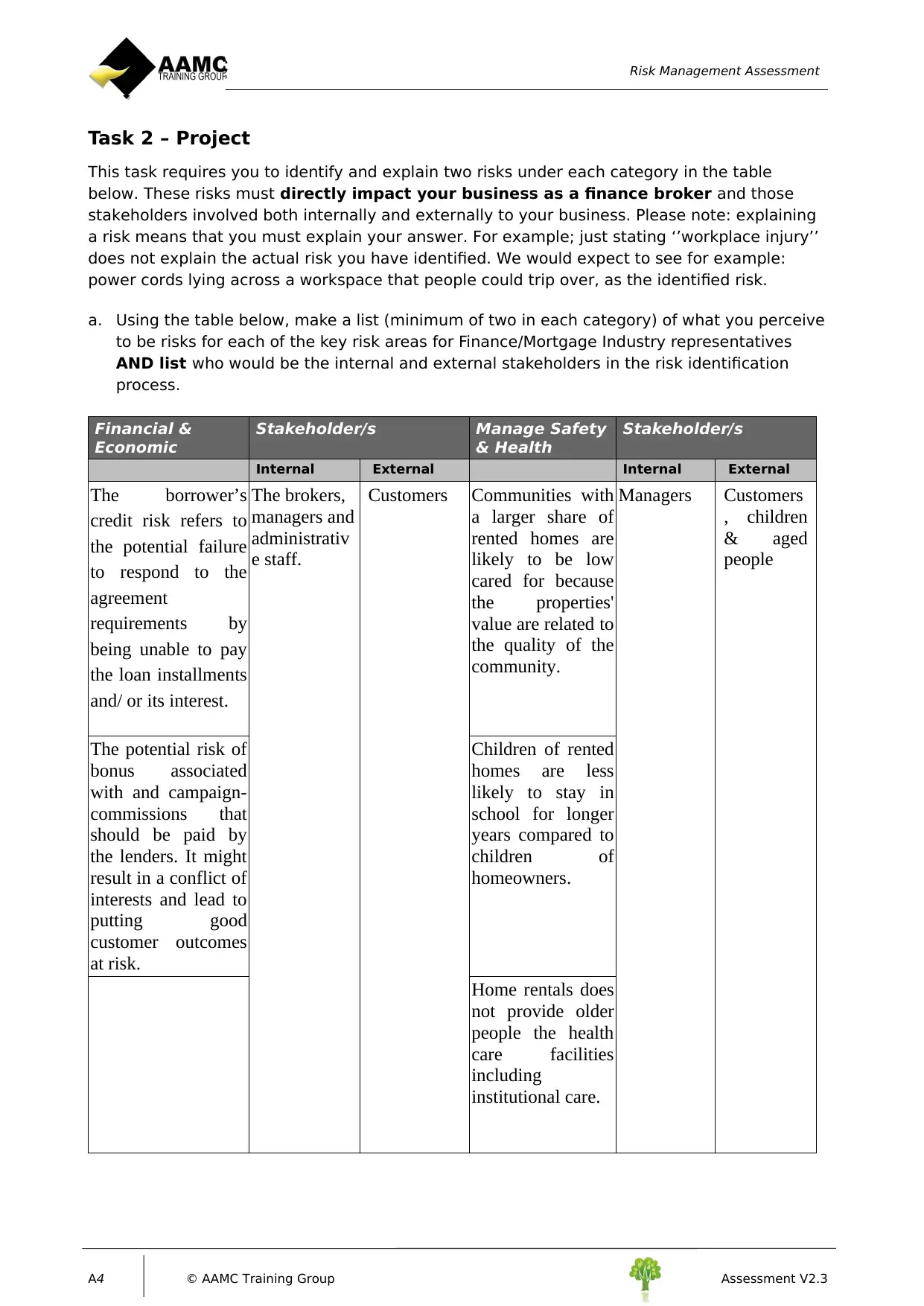
Risk Management Assessment
Task 2 – Project
This task requires you to identify and explain two risks under each category in the table
below. These risks must directly impact your business as a finance broker and those
stakeholders involved both internally and externally to your business. Please note: explaining
a risk means that you must explain your answer. For example; just stating ‘’workplace injury’’
does not explain the actual risk you have identified. We would expect to see for example:
power cords lying across a workspace that people could trip over, as the identified risk.
a. Using the table below, make a list (minimum of two in each category) of what you perceive
to be risks for each of the key risk areas for Finance/Mortgage Industry representatives
AND list who would be the internal and external stakeholders in the risk identification
process.
Financial &
Economic
Stakeholder/s Manage Safety
& Health
Stakeholder/s
Internal External Internal External
The borrower’s
credit risk refers to
the potential failure
to respond to the
agreement
requirements by
being unable to pay
the loan installments
and/ or its interest.
The brokers,
managers and
administrativ
e staff.
Customers Communities with
a larger share of
rented homes are
likely to be low
cared for because
the properties'
value are related to
the quality of the
community.
Managers Customers
, children
& aged
people
The potential risk of
bonus associated
with and campaign-
commissions that
should be paid by
the lenders. It might
result in a conflict of
interests and lead to
putting good
customer outcomes
at risk.
Children of rented
homes are less
likely to stay in
school for longer
years compared to
children of
homeowners.
Home rentals does
not provide older
people the health
care facilities
including
institutional care.
A4 © AAMC Training Group Assessment V2.3
Task 2 – Project
This task requires you to identify and explain two risks under each category in the table
below. These risks must directly impact your business as a finance broker and those
stakeholders involved both internally and externally to your business. Please note: explaining
a risk means that you must explain your answer. For example; just stating ‘’workplace injury’’
does not explain the actual risk you have identified. We would expect to see for example:
power cords lying across a workspace that people could trip over, as the identified risk.
a. Using the table below, make a list (minimum of two in each category) of what you perceive
to be risks for each of the key risk areas for Finance/Mortgage Industry representatives
AND list who would be the internal and external stakeholders in the risk identification
process.
Financial &
Economic
Stakeholder/s Manage Safety
& Health
Stakeholder/s
Internal External Internal External
The borrower’s
credit risk refers to
the potential failure
to respond to the
agreement
requirements by
being unable to pay
the loan installments
and/ or its interest.
The brokers,
managers and
administrativ
e staff.
Customers Communities with
a larger share of
rented homes are
likely to be low
cared for because
the properties'
value are related to
the quality of the
community.
Managers Customers
, children
& aged
people
The potential risk of
bonus associated
with and campaign-
commissions that
should be paid by
the lenders. It might
result in a conflict of
interests and lead to
putting good
customer outcomes
at risk.
Children of rented
homes are less
likely to stay in
school for longer
years compared to
children of
homeowners.
Home rentals does
not provide older
people the health
care facilities
including
institutional care.
A4 © AAMC Training Group Assessment V2.3
Secure Best Marks with AI Grader
Need help grading? Try our AI Grader for instant feedback on your assignments.

Risk Management Assessment
Regulatory/Legal Stakeholder/s Professionalis
m and
Reputation
Stakeholder/s
Internal External Internal External
Regulators have
been devoting their
efforts to risk
mitigation and
reduction in the
financial system,
especially disclosure
and governance.
Managers and
employees
Governmen
t
The risk of being
highly
concentrated on
particular areas.
Top
managemen
t and
marketing
Customers
The mortgage
broking industry
suffers from risks
associated with
broker
remuneration, its
structure and
transparency of
reporting the success
of relationships
between brokers and
lenders.
Not diversifying
risk by mortgage
brokers through
offering a single
channel.
Marketing documentation Stakeholder/s
Internal External
Disapproval of mortgage brokers by lenders that increases marketing
risk.
Top
management
and
marketing
manager
Customer
s
The risk associated with brand perception could be caused by
mortgage brokers who do not market themselves to gain leadership.
Source: Deloitte Touche Tohmatsu (2018)
b. Once completed; provide a brief commentary on your understanding of the Australian
Standard AS/NZS ISO 31000:2009 Risk management — Principles and guidelines, i.e.
definition and how it affects you as a Finance/Mortgage Industry representative.
The risk management of AS/NZS ISO 31000:2009, provides principles and guidelines to be used
by different entities, including public, private or community enterprise. Accordingly, these
principles are not tailored to specific industry, therefore they could be applied throughout the
organization life and its various activities. Also, being an international standard, it could be applied
to any risk type. The implementation of these standards should consider the varying needs of every
organization. It identifies risk to be the uncertainty effect on objectives, it is characterized by
reference to a probable event. The effect refers to the deviation from the expected action that could
be positive or negative (Standards Australia, 2009).
Assessment V2.3 © AAMC Training Group A5
Regulatory/Legal Stakeholder/s Professionalis
m and
Reputation
Stakeholder/s
Internal External Internal External
Regulators have
been devoting their
efforts to risk
mitigation and
reduction in the
financial system,
especially disclosure
and governance.
Managers and
employees
Governmen
t
The risk of being
highly
concentrated on
particular areas.
Top
managemen
t and
marketing
Customers
The mortgage
broking industry
suffers from risks
associated with
broker
remuneration, its
structure and
transparency of
reporting the success
of relationships
between brokers and
lenders.
Not diversifying
risk by mortgage
brokers through
offering a single
channel.
Marketing documentation Stakeholder/s
Internal External
Disapproval of mortgage brokers by lenders that increases marketing
risk.
Top
management
and
marketing
manager
Customer
s
The risk associated with brand perception could be caused by
mortgage brokers who do not market themselves to gain leadership.
Source: Deloitte Touche Tohmatsu (2018)
b. Once completed; provide a brief commentary on your understanding of the Australian
Standard AS/NZS ISO 31000:2009 Risk management — Principles and guidelines, i.e.
definition and how it affects you as a Finance/Mortgage Industry representative.
The risk management of AS/NZS ISO 31000:2009, provides principles and guidelines to be used
by different entities, including public, private or community enterprise. Accordingly, these
principles are not tailored to specific industry, therefore they could be applied throughout the
organization life and its various activities. Also, being an international standard, it could be applied
to any risk type. The implementation of these standards should consider the varying needs of every
organization. It identifies risk to be the uncertainty effect on objectives, it is characterized by
reference to a probable event. The effect refers to the deviation from the expected action that could
be positive or negative (Standards Australia, 2009).
Assessment V2.3 © AAMC Training Group A5
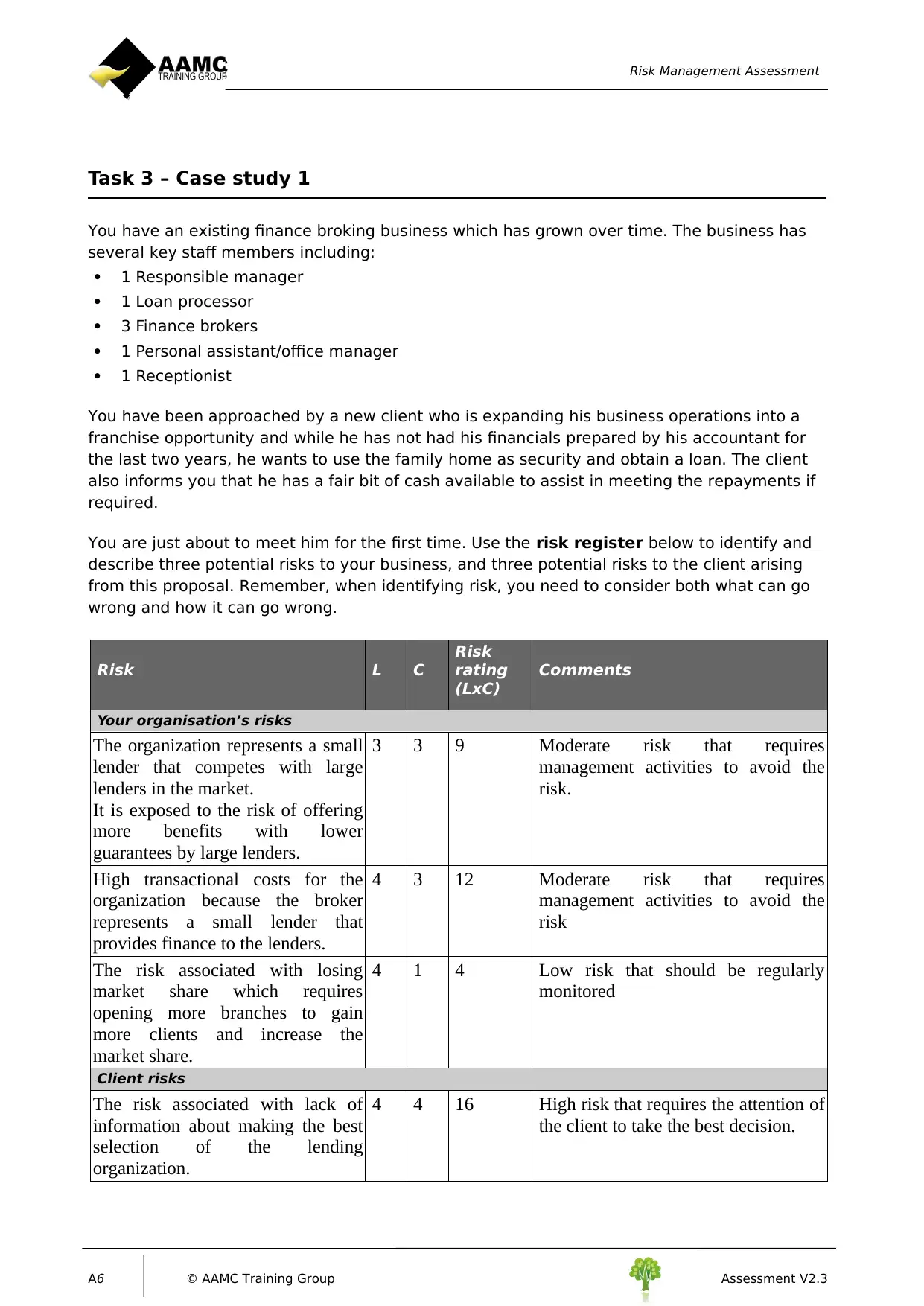
Risk Management Assessment
Task 3 – Case study 1
You have an existing finance broking business which has grown over time. The business has
several key staff members including:
1 Responsible manager
1 Loan processor
3 Finance brokers
1 Personal assistant/office manager
1 Receptionist
You have been approached by a new client who is expanding his business operations into a
franchise opportunity and while he has not had his financials prepared by his accountant for
the last two years, he wants to use the family home as security and obtain a loan. The client
also informs you that he has a fair bit of cash available to assist in meeting the repayments if
required.
You are just about to meet him for the first time. Use the risk register below to identify and
describe three potential risks to your business, and three potential risks to the client arising
from this proposal. Remember, when identifying risk, you need to consider both what can go
wrong and how it can go wrong.
Risk L C
Risk
rating
(LxC)
Comments
Your organisation’s risks
The organization represents a small
lender that competes with large
lenders in the market.
It is exposed to the risk of offering
more benefits with lower
guarantees by large lenders.
3 3 9 Moderate risk that requires
management activities to avoid the
risk.
High transactional costs for the
organization because the broker
represents a small lender that
provides finance to the lenders.
4 3 12 Moderate risk that requires
management activities to avoid the
risk
The risk associated with losing
market share which requires
opening more branches to gain
more clients and increase the
market share.
4 1 4 Low risk that should be regularly
monitored
Client risks
The risk associated with lack of
information about making the best
selection of the lending
organization.
4 4 16 High risk that requires the attention of
the client to take the best decision.
A6 © AAMC Training Group Assessment V2.3
Task 3 – Case study 1
You have an existing finance broking business which has grown over time. The business has
several key staff members including:
1 Responsible manager
1 Loan processor
3 Finance brokers
1 Personal assistant/office manager
1 Receptionist
You have been approached by a new client who is expanding his business operations into a
franchise opportunity and while he has not had his financials prepared by his accountant for
the last two years, he wants to use the family home as security and obtain a loan. The client
also informs you that he has a fair bit of cash available to assist in meeting the repayments if
required.
You are just about to meet him for the first time. Use the risk register below to identify and
describe three potential risks to your business, and three potential risks to the client arising
from this proposal. Remember, when identifying risk, you need to consider both what can go
wrong and how it can go wrong.
Risk L C
Risk
rating
(LxC)
Comments
Your organisation’s risks
The organization represents a small
lender that competes with large
lenders in the market.
It is exposed to the risk of offering
more benefits with lower
guarantees by large lenders.
3 3 9 Moderate risk that requires
management activities to avoid the
risk.
High transactional costs for the
organization because the broker
represents a small lender that
provides finance to the lenders.
4 3 12 Moderate risk that requires
management activities to avoid the
risk
The risk associated with losing
market share which requires
opening more branches to gain
more clients and increase the
market share.
4 1 4 Low risk that should be regularly
monitored
Client risks
The risk associated with lack of
information about making the best
selection of the lending
organization.
4 4 16 High risk that requires the attention of
the client to take the best decision.
A6 © AAMC Training Group Assessment V2.3
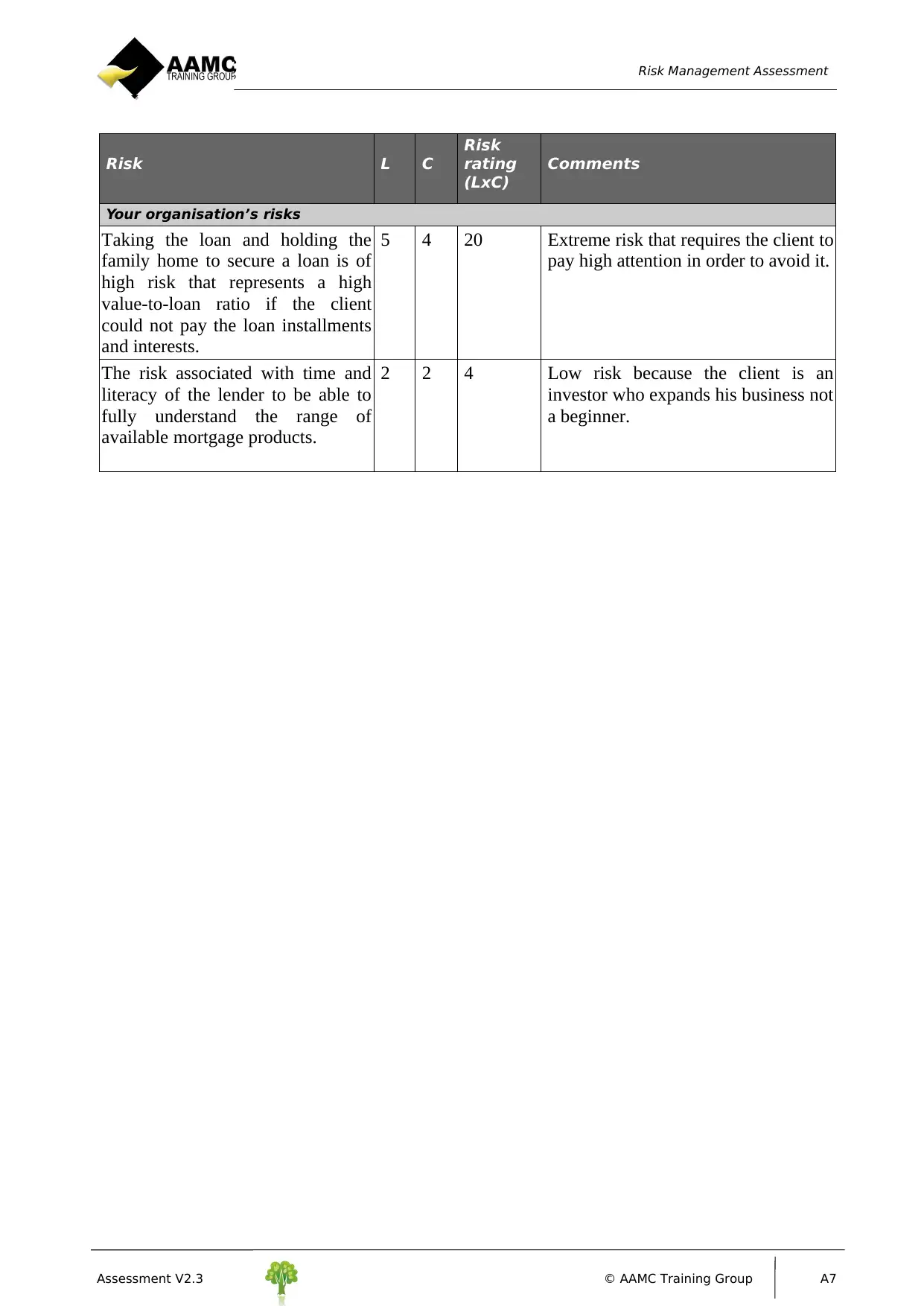
Risk Management Assessment
Risk L C
Risk
rating
(LxC)
Comments
Your organisation’s risks
Taking the loan and holding the
family home to secure a loan is of
high risk that represents a high
value-to-loan ratio if the client
could not pay the loan installments
and interests.
5 4 20 Extreme risk that requires the client to
pay high attention in order to avoid it.
The risk associated with time and
literacy of the lender to be able to
fully understand the range of
available mortgage products.
2 2 4 Low risk because the client is an
investor who expands his business not
a beginner.
Assessment V2.3 © AAMC Training Group A7
Risk L C
Risk
rating
(LxC)
Comments
Your organisation’s risks
Taking the loan and holding the
family home to secure a loan is of
high risk that represents a high
value-to-loan ratio if the client
could not pay the loan installments
and interests.
5 4 20 Extreme risk that requires the client to
pay high attention in order to avoid it.
The risk associated with time and
literacy of the lender to be able to
fully understand the range of
available mortgage products.
2 2 4 Low risk because the client is an
investor who expands his business not
a beginner.
Assessment V2.3 © AAMC Training Group A7
Paraphrase This Document
Need a fresh take? Get an instant paraphrase of this document with our AI Paraphraser
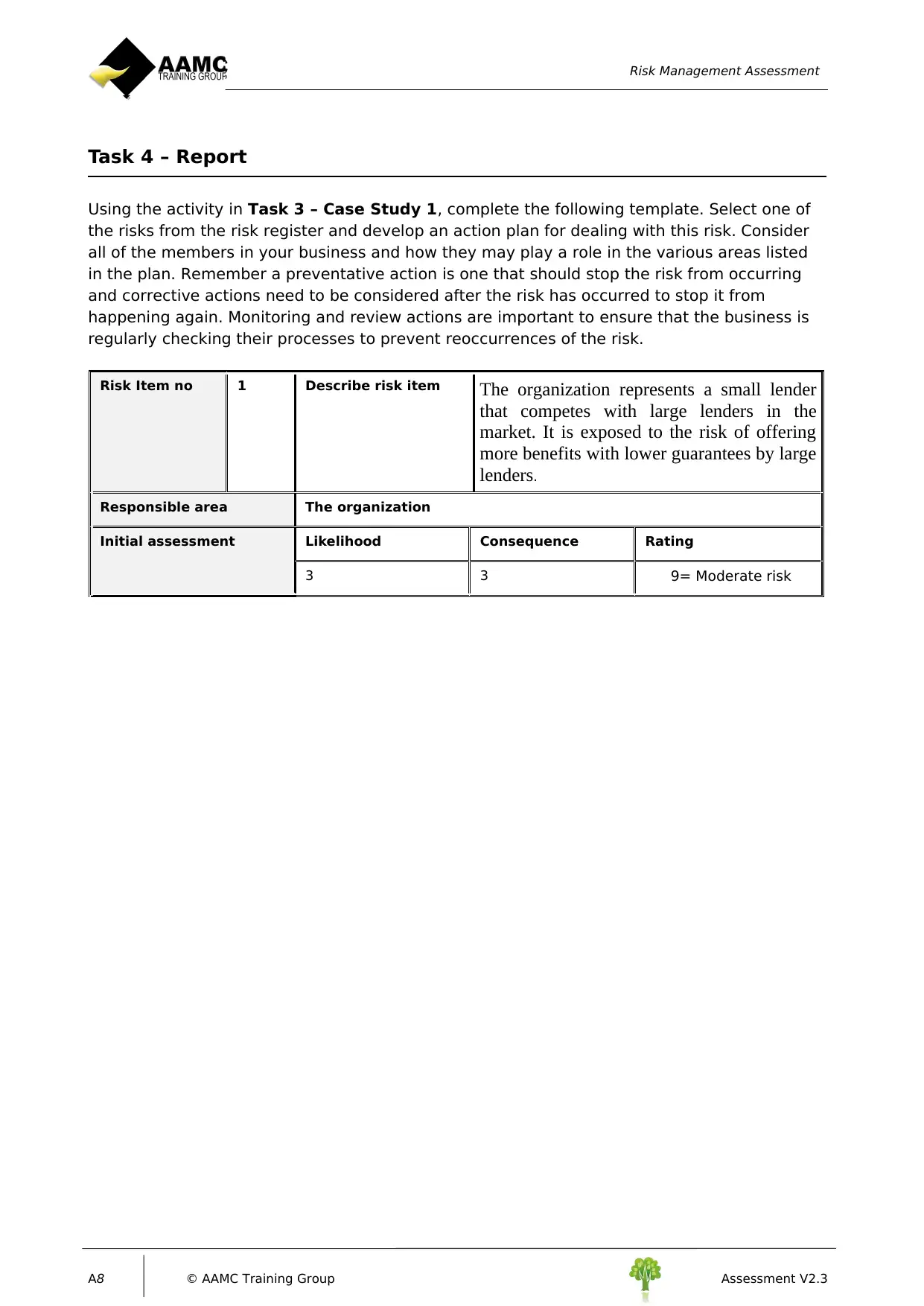
Risk Management Assessment
Task 4 – Report
Using the activity in Task 3 – Case Study 1, complete the following template. Select one of
the risks from the risk register and develop an action plan for dealing with this risk. Consider
all of the members in your business and how they may play a role in the various areas listed
in the plan. Remember a preventative action is one that should stop the risk from occurring
and corrective actions need to be considered after the risk has occurred to stop it from
happening again. Monitoring and review actions are important to ensure that the business is
regularly checking their processes to prevent reoccurrences of the risk.
Risk Item no 1 Describe risk item The organization represents a small lender
that competes with large lenders in the
market. It is exposed to the risk of offering
more benefits with lower guarantees by large
lenders.
Responsible area The organization
Initial assessment Likelihood Consequence Rating
3 3 9= Moderate risk
A8 © AAMC Training Group Assessment V2.3
Task 4 – Report
Using the activity in Task 3 – Case Study 1, complete the following template. Select one of
the risks from the risk register and develop an action plan for dealing with this risk. Consider
all of the members in your business and how they may play a role in the various areas listed
in the plan. Remember a preventative action is one that should stop the risk from occurring
and corrective actions need to be considered after the risk has occurred to stop it from
happening again. Monitoring and review actions are important to ensure that the business is
regularly checking their processes to prevent reoccurrences of the risk.
Risk Item no 1 Describe risk item The organization represents a small lender
that competes with large lenders in the
market. It is exposed to the risk of offering
more benefits with lower guarantees by large
lenders.
Responsible area The organization
Initial assessment Likelihood Consequence Rating
3 3 9= Moderate risk
A8 © AAMC Training Group Assessment V2.3
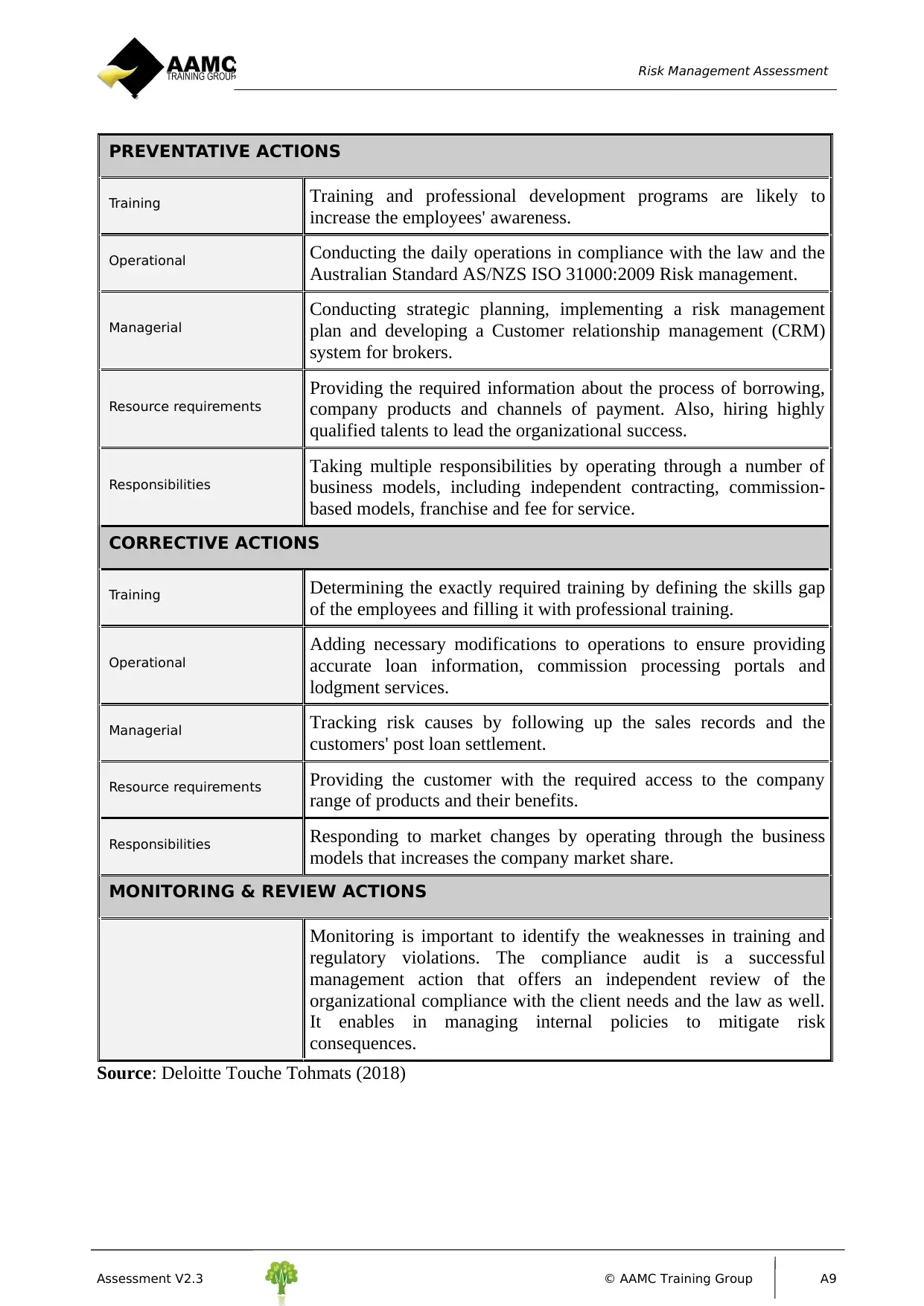
Risk Management Assessment
PREVENTATIVE ACTIONS
Training Training and professional development programs are likely to
increase the employees' awareness.
Operational Conducting the daily operations in compliance with the law and the
Australian Standard AS/NZS ISO 31000:2009 Risk management.
Managerial
Conducting strategic planning, implementing a risk management
plan and developing a Customer relationship management (CRM)
system for brokers.
Resource requirements
Providing the required information about the process of borrowing,
company products and channels of payment. Also, hiring highly
qualified talents to lead the organizational success.
Responsibilities
Taking multiple responsibilities by operating through a number of
business models, including independent contracting, commission-
based models, franchise and fee for service.
CORRECTIVE ACTIONS
Training Determining the exactly required training by defining the skills gap
of the employees and filling it with professional training.
Operational
Adding necessary modifications to operations to ensure providing
accurate loan information, commission processing portals and
lodgment services.
Managerial Tracking risk causes by following up the sales records and the
customers' post loan settlement.
Resource requirements Providing the customer with the required access to the company
range of products and their benefits.
Responsibilities Responding to market changes by operating through the business
models that increases the company market share.
MONITORING & REVIEW ACTIONS
Monitoring is important to identify the weaknesses in training and
regulatory violations. The compliance audit is a successful
management action that offers an independent review of the
organizational compliance with the client needs and the law as well.
It enables in managing internal policies to mitigate risk
consequences.
Source: Deloitte Touche Tohmats (2018)
Assessment V2.3 © AAMC Training Group A9
PREVENTATIVE ACTIONS
Training Training and professional development programs are likely to
increase the employees' awareness.
Operational Conducting the daily operations in compliance with the law and the
Australian Standard AS/NZS ISO 31000:2009 Risk management.
Managerial
Conducting strategic planning, implementing a risk management
plan and developing a Customer relationship management (CRM)
system for brokers.
Resource requirements
Providing the required information about the process of borrowing,
company products and channels of payment. Also, hiring highly
qualified talents to lead the organizational success.
Responsibilities
Taking multiple responsibilities by operating through a number of
business models, including independent contracting, commission-
based models, franchise and fee for service.
CORRECTIVE ACTIONS
Training Determining the exactly required training by defining the skills gap
of the employees and filling it with professional training.
Operational
Adding necessary modifications to operations to ensure providing
accurate loan information, commission processing portals and
lodgment services.
Managerial Tracking risk causes by following up the sales records and the
customers' post loan settlement.
Resource requirements Providing the customer with the required access to the company
range of products and their benefits.
Responsibilities Responding to market changes by operating through the business
models that increases the company market share.
MONITORING & REVIEW ACTIONS
Monitoring is important to identify the weaknesses in training and
regulatory violations. The compliance audit is a successful
management action that offers an independent review of the
organizational compliance with the client needs and the law as well.
It enables in managing internal policies to mitigate risk
consequences.
Source: Deloitte Touche Tohmats (2018)
Assessment V2.3 © AAMC Training Group A9
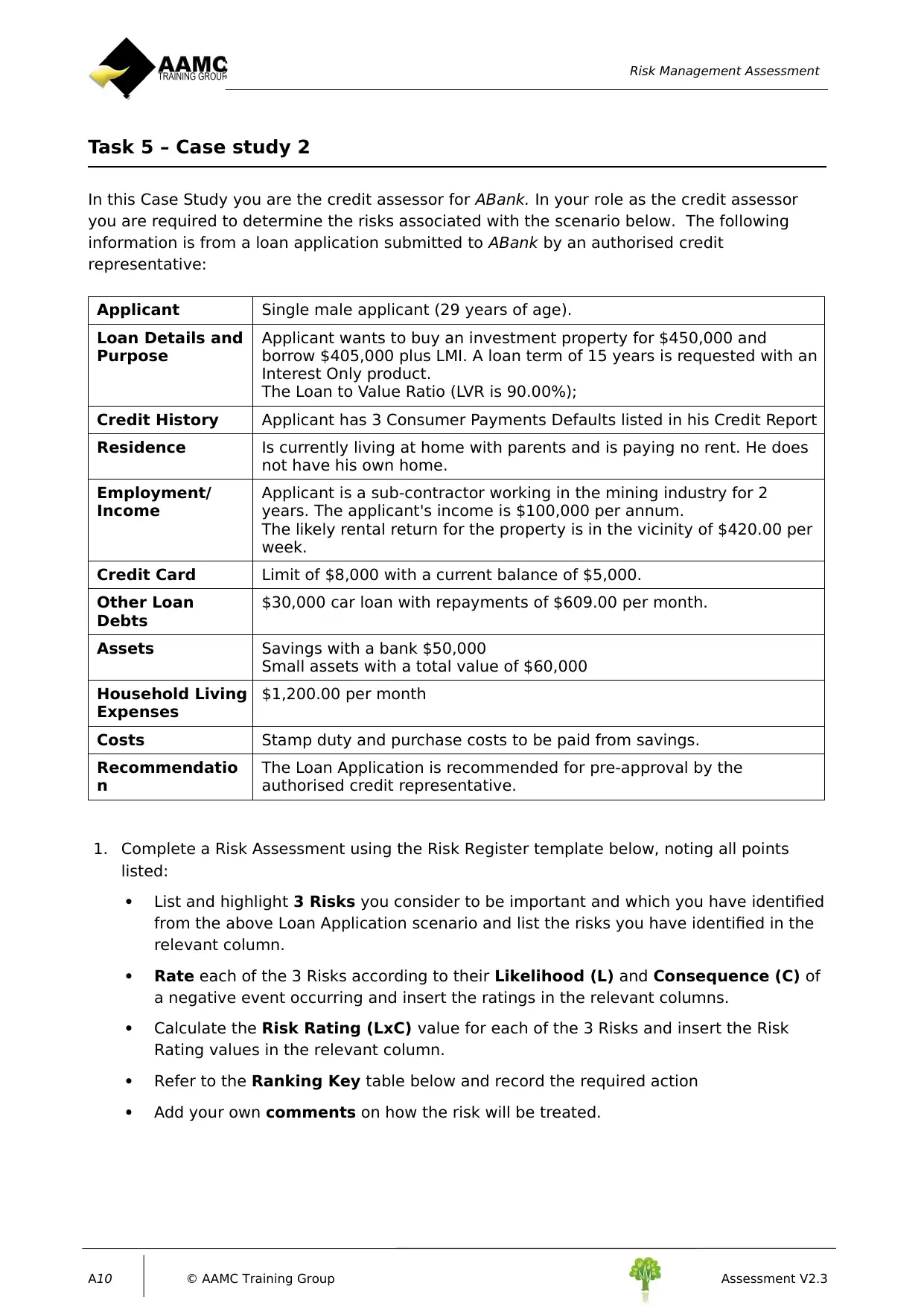
Risk Management Assessment
Task 5 – Case study 2
In this Case Study you are the credit assessor for ABank. In your role as the credit assessor
you are required to determine the risks associated with the scenario below. The following
information is from a loan application submitted to ABank by an authorised credit
representative:
Applicant Single male applicant (29 years of age).
Loan Details and
Purpose
Applicant wants to buy an investment property for $450,000 and
borrow $405,000 plus LMI. A loan term of 15 years is requested with an
Interest Only product.
The Loan to Value Ratio (LVR is 90.00%);
Credit History Applicant has 3 Consumer Payments Defaults listed in his Credit Report
Residence Is currently living at home with parents and is paying no rent. He does
not have his own home.
Employment/
Income
Applicant is a sub-contractor working in the mining industry for 2
years. The applicant's income is $100,000 per annum.
The likely rental return for the property is in the vicinity of $420.00 per
week.
Credit Card Limit of $8,000 with a current balance of $5,000.
Other Loan
Debts
$30,000 car loan with repayments of $609.00 per month.
Assets Savings with a bank $50,000
Small assets with a total value of $60,000
Household Living
Expenses
$1,200.00 per month
Costs Stamp duty and purchase costs to be paid from savings.
Recommendatio
n
The Loan Application is recommended for pre-approval by the
authorised credit representative.
1. Complete a Risk Assessment using the Risk Register template below, noting all points
listed:
List and highlight 3 Risks you consider to be important and which you have identified
from the above Loan Application scenario and list the risks you have identified in the
relevant column.
Rate each of the 3 Risks according to their Likelihood (L) and Consequence (C) of
a negative event occurring and insert the ratings in the relevant columns.
Calculate the Risk Rating (LxC) value for each of the 3 Risks and insert the Risk
Rating values in the relevant column.
Refer to the Ranking Key table below and record the required action
Add your own comments on how the risk will be treated.
A10 © AAMC Training Group Assessment V2.3
Task 5 – Case study 2
In this Case Study you are the credit assessor for ABank. In your role as the credit assessor
you are required to determine the risks associated with the scenario below. The following
information is from a loan application submitted to ABank by an authorised credit
representative:
Applicant Single male applicant (29 years of age).
Loan Details and
Purpose
Applicant wants to buy an investment property for $450,000 and
borrow $405,000 plus LMI. A loan term of 15 years is requested with an
Interest Only product.
The Loan to Value Ratio (LVR is 90.00%);
Credit History Applicant has 3 Consumer Payments Defaults listed in his Credit Report
Residence Is currently living at home with parents and is paying no rent. He does
not have his own home.
Employment/
Income
Applicant is a sub-contractor working in the mining industry for 2
years. The applicant's income is $100,000 per annum.
The likely rental return for the property is in the vicinity of $420.00 per
week.
Credit Card Limit of $8,000 with a current balance of $5,000.
Other Loan
Debts
$30,000 car loan with repayments of $609.00 per month.
Assets Savings with a bank $50,000
Small assets with a total value of $60,000
Household Living
Expenses
$1,200.00 per month
Costs Stamp duty and purchase costs to be paid from savings.
Recommendatio
n
The Loan Application is recommended for pre-approval by the
authorised credit representative.
1. Complete a Risk Assessment using the Risk Register template below, noting all points
listed:
List and highlight 3 Risks you consider to be important and which you have identified
from the above Loan Application scenario and list the risks you have identified in the
relevant column.
Rate each of the 3 Risks according to their Likelihood (L) and Consequence (C) of
a negative event occurring and insert the ratings in the relevant columns.
Calculate the Risk Rating (LxC) value for each of the 3 Risks and insert the Risk
Rating values in the relevant column.
Refer to the Ranking Key table below and record the required action
Add your own comments on how the risk will be treated.
A10 © AAMC Training Group Assessment V2.3
Secure Best Marks with AI Grader
Need help grading? Try our AI Grader for instant feedback on your assignments.
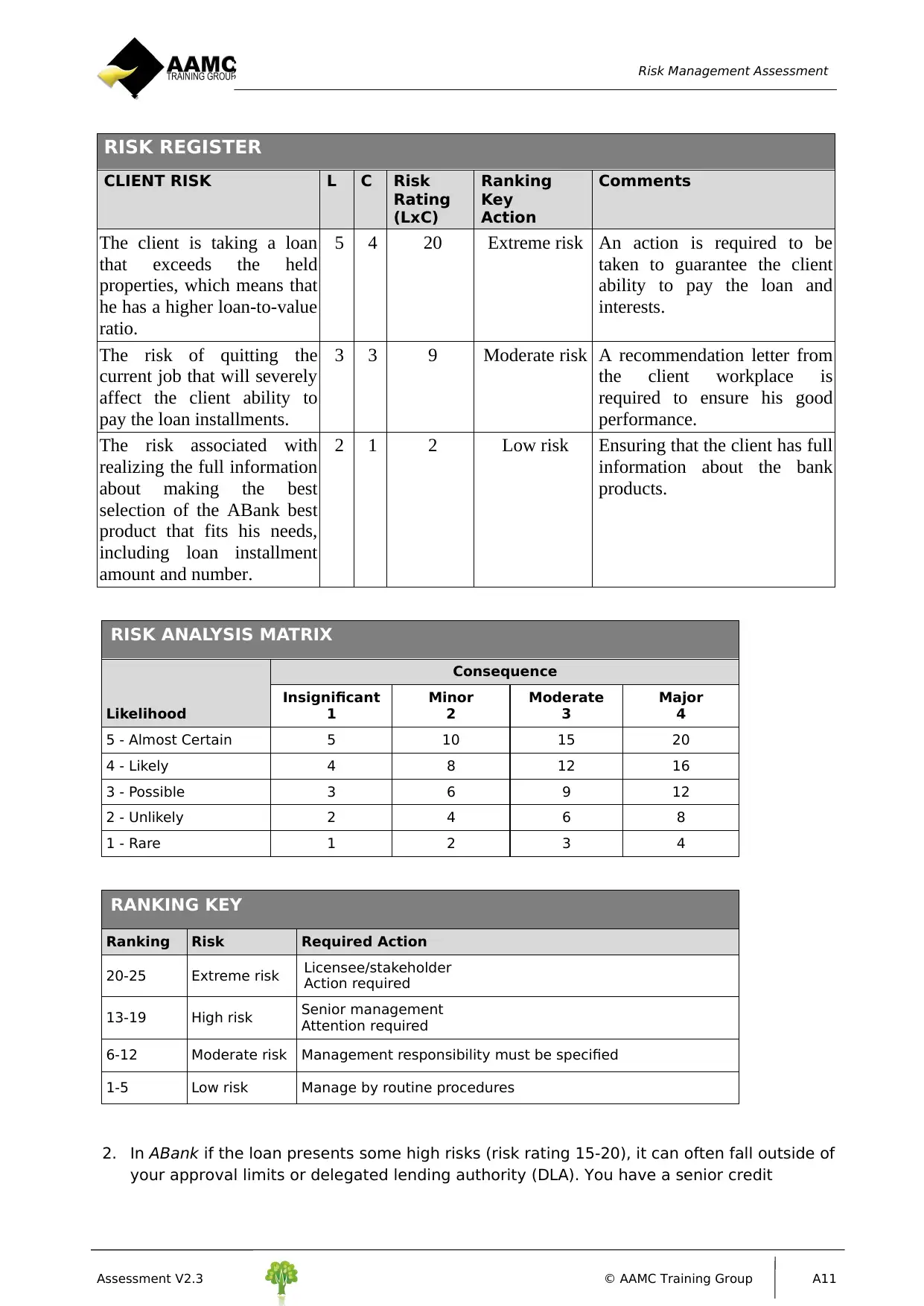
Risk Management Assessment
RISK REGISTER
CLIENT RISK L C Risk
Rating
(LxC)
Ranking
Key
Action
Comments
The client is taking a loan
that exceeds the held
properties, which means that
he has a higher loan-to-value
ratio.
5 4 20 Extreme risk An action is required to be
taken to guarantee the client
ability to pay the loan and
interests.
The risk of quitting the
current job that will severely
affect the client ability to
pay the loan installments.
3 3 9 Moderate risk A recommendation letter from
the client workplace is
required to ensure his good
performance.
The risk associated with
realizing the full information
about making the best
selection of the ABank best
product that fits his needs,
including loan installment
amount and number.
2 1 2 Low risk Ensuring that the client has full
information about the bank
products.
RISK ANALYSIS MATRIX
Likelihood
Consequence
Insignificant
1
Minor
2
Moderate
3
Major
4
5 - Almost Certain 5 10 15 20
4 - Likely 4 8 12 16
3 - Possible 3 6 9 12
2 - Unlikely 2 4 6 8
1 - Rare 1 2 3 4
RANKING KEY
Ranking Risk Required Action
20-25 Extreme risk Licensee/stakeholder
Action required
13-19 High risk Senior management
Attention required
6-12 Moderate risk Management responsibility must be specified
1-5 Low risk Manage by routine procedures
2. In ABank if the loan presents some high risks (risk rating 15-20), it can often fall outside of
your approval limits or delegated lending authority (DLA). You have a senior credit
Assessment V2.3 © AAMC Training Group A11
RISK REGISTER
CLIENT RISK L C Risk
Rating
(LxC)
Ranking
Key
Action
Comments
The client is taking a loan
that exceeds the held
properties, which means that
he has a higher loan-to-value
ratio.
5 4 20 Extreme risk An action is required to be
taken to guarantee the client
ability to pay the loan and
interests.
The risk of quitting the
current job that will severely
affect the client ability to
pay the loan installments.
3 3 9 Moderate risk A recommendation letter from
the client workplace is
required to ensure his good
performance.
The risk associated with
realizing the full information
about making the best
selection of the ABank best
product that fits his needs,
including loan installment
amount and number.
2 1 2 Low risk Ensuring that the client has full
information about the bank
products.
RISK ANALYSIS MATRIX
Likelihood
Consequence
Insignificant
1
Minor
2
Moderate
3
Major
4
5 - Almost Certain 5 10 15 20
4 - Likely 4 8 12 16
3 - Possible 3 6 9 12
2 - Unlikely 2 4 6 8
1 - Rare 1 2 3 4
RANKING KEY
Ranking Risk Required Action
20-25 Extreme risk Licensee/stakeholder
Action required
13-19 High risk Senior management
Attention required
6-12 Moderate risk Management responsibility must be specified
1-5 Low risk Manage by routine procedures
2. In ABank if the loan presents some high risks (risk rating 15-20), it can often fall outside of
your approval limits or delegated lending authority (DLA). You have a senior credit
Assessment V2.3 © AAMC Training Group A11
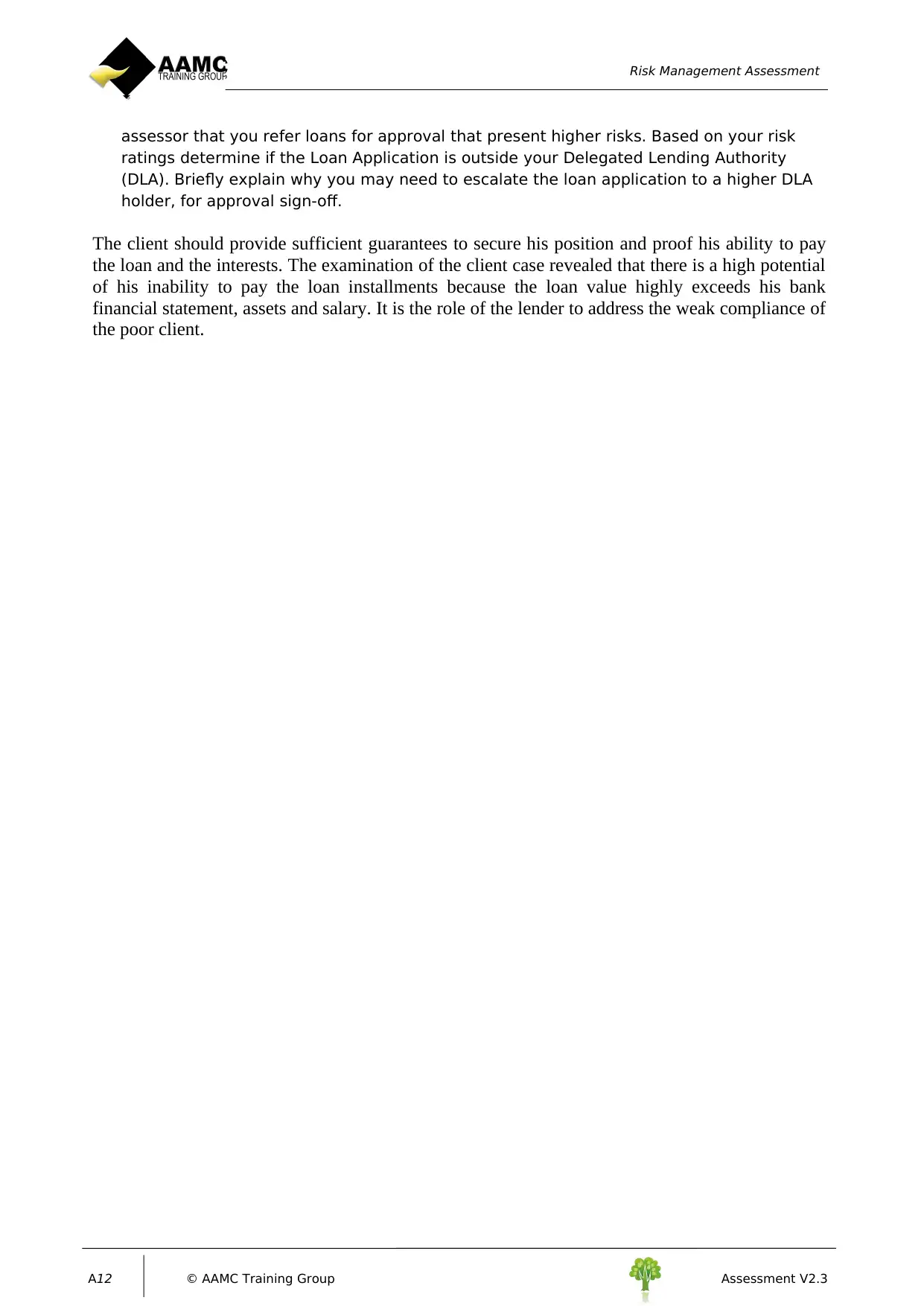
Risk Management Assessment
assessor that you refer loans for approval that present higher risks. Based on your risk
ratings determine if the Loan Application is outside your Delegated Lending Authority
(DLA). Briefly explain why you may need to escalate the loan application to a higher DLA
holder, for approval sign-off.
The client should provide sufficient guarantees to secure his position and proof his ability to pay
the loan and the interests. The examination of the client case revealed that there is a high potential
of his inability to pay the loan installments because the loan value highly exceeds his bank
financial statement, assets and salary. It is the role of the lender to address the weak compliance of
the poor client.
A12 © AAMC Training Group Assessment V2.3
assessor that you refer loans for approval that present higher risks. Based on your risk
ratings determine if the Loan Application is outside your Delegated Lending Authority
(DLA). Briefly explain why you may need to escalate the loan application to a higher DLA
holder, for approval sign-off.
The client should provide sufficient guarantees to secure his position and proof his ability to pay
the loan and the interests. The examination of the client case revealed that there is a high potential
of his inability to pay the loan installments because the loan value highly exceeds his bank
financial statement, assets and salary. It is the role of the lender to address the weak compliance of
the poor client.
A12 © AAMC Training Group Assessment V2.3

Risk Management Assessment
References
Deloitte Touche Tohmatsu., 2018. The Value of Mortgage Broking, Australia: Deloitte Touche
Tohmatsu..
Standards Australia, 2009. AS/NZS ISO 31000:2009- Risk management—Principles and
guidelines, Australia: Standards Australia.
Assessment V2.3 © AAMC Training Group A13
References
Deloitte Touche Tohmatsu., 2018. The Value of Mortgage Broking, Australia: Deloitte Touche
Tohmatsu..
Standards Australia, 2009. AS/NZS ISO 31000:2009- Risk management—Principles and
guidelines, Australia: Standards Australia.
Assessment V2.3 © AAMC Training Group A13
1 out of 13
Related Documents
Your All-in-One AI-Powered Toolkit for Academic Success.
+13062052269
info@desklib.com
Available 24*7 on WhatsApp / Email
![[object Object]](/_next/static/media/star-bottom.7253800d.svg)
Unlock your academic potential
© 2024 | Zucol Services PVT LTD | All rights reserved.





